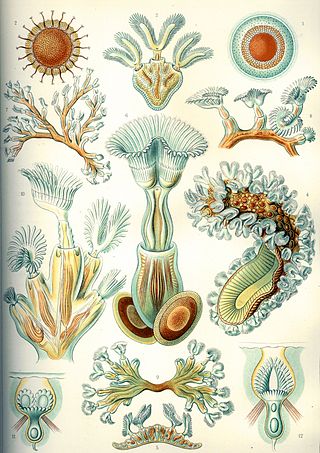
Bryozoa are a phylum of simple, aquatic invertebrate animals, nearly all living in sedentary colonies. Typically about 0.5 millimetres long, they have a special feeding structure called a lophophore, a "crown" of tentacles used for filter feeding. Most marine bryozoans live in tropical waters, but a few are found in oceanic trenches and polar waters. The bryozoans are classified as the marine bryozoans (Stenolaemata), freshwater bryozoans (Phylactolaemata), and mostly-marine bryozoans (Gymnolaemata), a few members of which prefer brackish water. 5,869 living species are known. At least two genera are solitary ; the rest are colonial.

Graptolites are a group of colonial animals, members of the subclass Graptolithina within the class Pterobranchia. These filter-feeding organisms are known chiefly from fossils found from the Middle Cambrian through the Lower Carboniferous (Mississippian). A possible early graptolite, Chaunograptus, is known from the Middle Cambrian. Recent analyses have favored the idea that the living pterobranch Rhabdopleura represents an extant graptolite which diverged from the rest of the group in the Cambrian. Fossil graptolites and Rhabdopleura share a colony structure of interconnected zooids housed in organic tubes (theca) which have a basic structure of stacked half-rings (fuselli). Most extinct graptolites belong to two major orders: the bush-like sessile Dendroidea and the planktonic, free-floating Graptoloidea. These orders most likely evolved from encrusting pterobranchs similar to Rhabdopleura. Due to their widespread abundance, planktonic lifestyle, and well-traced evolutionary trends, graptoloids in particular are useful index fossils for the Ordovician and Silurian periods.
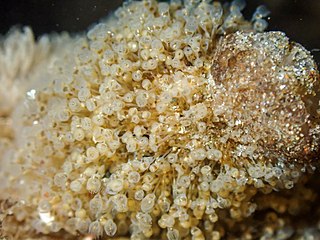
Entoprocta, or Kamptozoa, is a phylum of mostly sessile aquatic animals, ranging from 0.1 to 7 millimetres long. Mature individuals are goblet-shaped, on relatively long stalks. They have a "crown" of solid tentacles whose cilia generate water currents that draw food particles towards the mouth, and both the mouth and anus lie inside the "crown". The superficially similar Bryozoa (Ectoprocta) have the anus outside a "crown" of hollow tentacles. Most families of entoprocts are colonial, and all but 2 of the 150 species are marine. A few solitary species can move slowly.

Gymnolaemata are a class of Bryozoans. Gymnolaemata are sessile, mostly marine organisms and grow on the surfaces of rocks, kelp, and in some cases on animals, like fish. Zooids are cylindrical or flattened. The lophophore is protruded by action of muscles pulling on the frontal wall. This order includes the majority of living bryozoan species.

Membraniporidae is a bryozoan family in the order Cheilostomatida. Membranipora form encrusting or erect colonies; they are unilaminar or bilaminar and weakly to well-calcified. Zooids have vertical and basal calcified walls, but virtually no frontal calcified wall: most of the frontal surface is occupied by frontal membrane. An intertentacular organ is also present. The larvae are not brooded. The ancestrula is generally twinned. Kenozooids may be present in a few species; modified zooids analogous to avicularia are rare.

Cyclostomatida, or cyclostomata, are an ancient order of stenolaemate bryozoans which first appeared in the Lower Ordovician. It consists of 7+ suborders, 59+ families, 373+ genera, and 666+ species. The cyclostome bryozoans were dominant in the Mesozoic; since that era, they have decreased. Currently, cyclostomes seldom constitute more than 20% of the species recorded in regional bryozoan faunas.

Ascophora is an infraorder under order Cheilostomatida of the Bryozoa.
The ascus is a diagnostic morphological feature of the bryozoan suborder Ascophora. It is a water-filled sac of frontal membrane opening (ascopore) at or near the zooid orifice. It functions as a hydrostatic system by allowing water into the space below the inflexible, calcified frontal wall when the zooid everts its polypide by muscles pulling the frontal membrane inwards. The ascus, along with a calcified frontal shield, define ascophoran bryozoa.

Malacostegina is a sub-order of marine, colonial bryozoans in the order Cheilostomatida. The structure of the individual zooids is generally simple, with an uncalcified, flexible frontal wall. This sub-order includes the earliest known cheilostome, in the genus Pyriporopsis (Electridae).

Flustrina is a suborder under the order Cheilostomatida of gymnolaematan Bryozoa.
The avicularium in cheilostome bryozoans is a modified, non-feeding zooid. The operculum, which normally closes the orifice when the zooids tentacles are retracted, has been modified to become a mandible. Strong muscles operate it. The polypide is greatly reduced, and the individual receives nourishment from neighboring zooids. The shape of the avicularian zooid can be identical to the feeding autozooid, but is usually elongated in the direction of the mandible.

The Cribrilinidae family is a part of the suborder Ascophora within the bryozoans. They are characterized by numerous spinose ribs (costae) overarching the frontal membrane of each zooid.
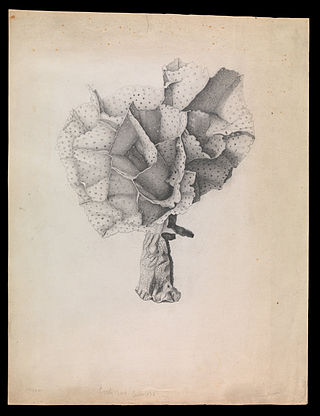
The Adeonidae is a family within the bryozoan order Cheilostomatida. Colonies are often upright bilaminar branches or sheets, perforated by large holes in some species. The zooids generally have one or more adventitious avicularia on their frontal wall. Instead of ovicells the adeonids often possess enlarged polymorphs which brood the larvae internally.

The Stomachetosellidae is a family within the bryozoan order Cheilostomatida. Colonies are encrusting on shells and rocks or upright bilaminar branches or sheets. The zooids generally have at least one adventitious avicularia on their frontal wall near the orifice. The frontal wall is usually covered with small pores and numerous larger pores along the margin. The ovicell, which broods the larvae internally, is double-layered with numerous pores in the outer layer, and sits quite prominently on the frontal wall of the next zooid.

The Bitectiporidae is a family within the bryozoan order Cheilostomatida. Colonies are encrusting on shells and rocks or upright bilaminar branches or sheets. The zooids generally have at least one adventitious avicularia on their frontal wall near the orifice. The frontal wall is usually covered with small pores and numerous larger pores along the margin. The ovicell, which broods the larvae internally, is double-layered with numerous pores in the outer layer, and sits quite prominently on the frontal wall of the next zooid.
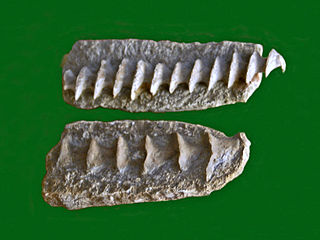
Archimedes is a genus of bryozoans belonging to the family Fenestellidae. The first use of the term "Archimedes" in relation to this genus was in 1838.

Atriolum robustum is a colonial tunicate or sea squirt in the family Didemnidae. It is native to the western and central Indo-Pacific where it is usually found anchored to a hard surface in shallow water.
Amathia vidovici is a species of colonial bryozoans with a tree-like structure. It is found in shallow waters over a wide geographical range, being found in both the Atlantic and Pacific Oceans and adjoining seas.
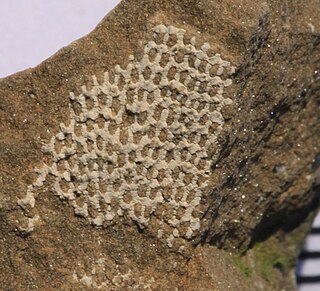
Fenestellidae is a family of bryozoans belonging to the order Fenestrida. The skeleton of its colonies consists of stiff branches that are interconnected by narrower crossbars. The individuals of the colony inhabit one side of the branches in two parallel rows or two at the branch base and three or more rows further up. Zooids can be recognized as small rimmed pores, and in well-preserved specimens the apertures are closed by centrally perforated lids. The front of the branches carries small nodes in a row or zigzag line between the apertures. Branches split from time to time giving the colonies a fan-shape or, in the genus Archimedes, create an mesh in the shape of an Archimedes screw.
Callopora lineata is a species of colonial bryozoan in the family Calloporidae. It is found on rocky shores in the Atlantic Ocean and the Mediterranean Sea.















